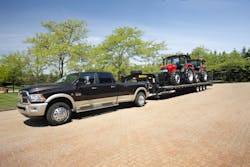Chrysler’s Ram Trucks division is beefing up performance attributes of its 2013 model Ram heavy duty pickups and chassis cab trucks, adding in a new cooling system and specially-designed air intake system for diesel-powered units, along with a factory-integrated fifth-wheel and gooseneck hitch mount option just for starters.
For 2013, Ram said all of its diesel-equipped trucks will be equipped with an all-new cooling system featuring a high-efficiency fan, dual radiators, dual transmission coolers and low-slung charge air cooler to boost heat-rejection capacity by 25%.
To further improve diesel performance while under load, Ram is also introducing what it calls the Ram Active Air intake system.
According to Michael Cairns, vehicle line executive for Ram Trucks, when the intake system senses extreme heat, it draws cooler air from the front of the vehicle instead of from the fender area – a function that also engages at high altitudes for superior throttle response in low oxygen environments.
“Warmer air is less dense and when most diesel sense that, they typically begins to de-rate – reducing available power just when the driver needs it the most,” he told Fleet Owner. “Our active air intake systems uses a valve to switch the air flow from down near the fender – where it gets hottest – to up by the front of the vehicle. That allows us to preserve engine power while under load in extreme heat or when in thinner mountain air.”
He added that when conditions are wet from snow, ice or water-fording, the system pulls air from an under-hood inlet, clear from snow packing and water.
Cairns noted that lower operating temperatures deliver improved performance, durability and lower operating costs over time – pointing out that Ram trucks that are spec’d with 6.7-liter Cummins turbocharged diesel engines also feature 15,000-mile oil change intervals. “That helps take TCO [total cost of ownership] down a notch over time,” Cairns said.
The ability to preserve diesel engine power in both hot weather and low oxygen environments with the new cooling and air intake system are just some of the reasons why the company is boosting the maximum trailer weight for its Ram 3500 truck models to 30,000 lbs. and its gross combined weight rating (GCWR) to 37,600 lbs.
That boost is also due the Ram 3500’s new 50,000 psi high-strength steel frame, improved transfer case, and higher-load transmission, along with larger-sized front drive shafts and U-joints to align with the increased weight ratings.
A new three-link front suspension, coupled to an advanced geometry rear suspension, further builds upon the chassis improvements to improve overall roll stiffness and enable the vehicles to handle not only higher GVWRs but heavy front loads as well, including snow plows.
Additionally, a newly designed Hotchkiss leaf spring rear suspension on the Ram 3500 offers improved ride and handling while delivering higher towing and payload capability.
The company added the Ram 2500 will also benefit from increased towing and GCWR ratings for the 2013 model year, with boosts to 18,350 lbs. and 25,000 lbs, respectively. Ram 5500 chassis cab trucks are also getting towing and GCWR upgrades, to 29,600 lbs. and 37,500 lbs., respectively.
Finally, Ram is adding a factory-integrated fifth-wheel and gooseneck hitch mount option, along with a 17,000 lb. Class V hitch with 1,800 pounds of tongue weight, electronic stability control (ESC) for dual-rear-wheels and a new center high-mounted stop light (CHMSL)–positioned camera to provide a full view of the bed for easier hook-up of fifth-wheel or gooseneck trailers as well as monitoring cargo.
Cairns said many of those improvements resulted not just from field research with customers and dealers, but from personal usage of trucks by Ram engineers as well.
“We all do a lot of trailering for example – I myself haul snowmobiles all over the place in the winter,” he said. “So we’re also looking at ways to improve things, many times based on our own personal experience driving fully-loaded trucks in all sorts of conditions.”
About the Author
Sean Kilcarr
Editor in Chief
Sean Kilcarr is a former longtime FleetOwner senior editor who wrote for the publication from 2000 to 2018. He served as editor-in-chief from 2017 to 2018.
